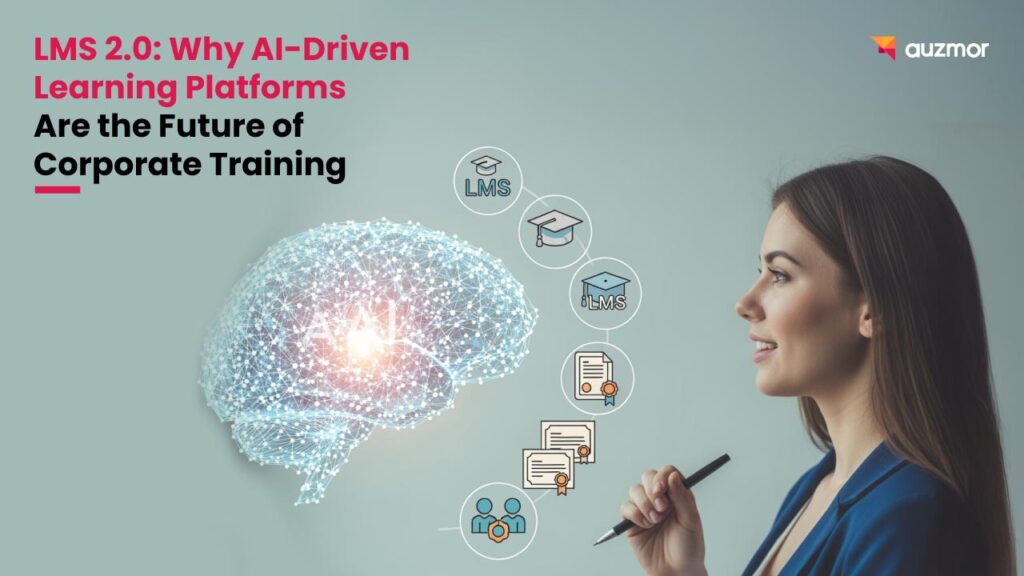Leading organizations have never been under more pressure to provide scalable and personalized learning that drives performance and ROI. Traditional Learning Management Systems (LMS), which are essentially static content libraries using narrow rules-based paths and manual reporting, are progressively being replaced by AI-enabled platforms which offer adaptive learning, predictive analytics, and seamless integrations. Historical analysis of data shows the global LMS market reached USD 24.05 billion in 2024 and is projected to grow at a 19.9% CAGR until 2030.
Meanwhile, for L&D leaders, Forrester research is showing generative AI is a required consideration in the selection of a platform, with 72 % responding that AI-enabled personalization was a higher priority than offering a legacy feature set. Examples of AI-enabled LMS deployments are revealing onboarding time to reduction of up to 40% and increases in learner engagement of up to 25%. For leaders, there are important considerations around governance, change management, and vendor due diligence.
Next-generation examples, like Auzmor LMS, using auto-recommendations, skills-gap diagnostics, and an API-first architecture, indicate how next-generation platforms are primed to meet these needs, and define the future of corporate learning.
Introduction:
Today’s businesses are faced with fast-changing skill demands, remote workers, and ROI demands. The need for adaptive, scalable learning is arguably more essential than ever: businesses need to repetitively upskill talent while also being capable of showing measurable performance impact. Traditional LMS’ have been centralized repositories—providing static courseware, requiring linear learning paths, and producing periodic, manually set reports. Human effort is needed for refresh and path changes, which interfere with agility and learner engagement.
By comparison, AI-Powered LMS utilize machine learning and predictive analytics to automatically curate content, develop adaptive learning paths, and reveal real-time learner behavior insights. These systems tap into recommendation engines—albeit of the sort used by consumer entertainment systems—to recommend bite-sized modules attuned to unique skill level and role-defined objectives. Predictive analytics uncover upcoming skills gaps before they become performance issues, allowing for proactive intervention. While older systems inform you of what occurred, AI-centric solutions inform you of what learners will require next—and dynamically realign as learning changes.
As employee expectations move toward on-demand, context-based experiences, the model of the LMS must change. This article analyzes market trends, compares core functions, function by function, uncovers business value through case examples, and defines strategic implications for executives guiding their organizations into an AI-facilitated learning future.
Market Trends and Data:
The global LMS market reached a value of USD 24.05 billion in 2024 and is anticipated to surpass USD 70.83 billion by 2030 with a galloping CAGR of 19.9% from 2025 to 2030. North America leads the market with a staggering 36% market share due to corporate spending and digitalization of higher education, with the Asia Pacific region showing the highest growth rate of all regions.
Based on Gartner’s 2024 Market Guide for Corporate Learning Technologies, analytics and artificial intelligence have evolved from being “innovation pockets” to being an expected normality for 45% of high-growth companies, a drastic rise from 28% in 2022. While the report observes that the platforms offering real-time predictive insights now command a 20% premium in their yearly subscription fee, Forrester’s 2024 State of AI Survey indicates that 68% of learning and development leaders use AI-driven personalization as the most important consideration in the selection of a platform, beating usability and price for the first time.
Drivers of fueling AI investment in LMS are:
- Remote/Hybrid Work: Remote workers need on-demand, context-specific learning experiences to be accessible everywhere.
- Skills Gaps: 56% of CEOs report talent shortages holding back growth, making L&D strategists focus on platforms that identify and fill skills gaps prior to affecting the bottom line.
- ROI Expectations: Finance executives now expect L&D initiatives to demonstrate performance improvement (e.g., time-to-competency, retention gain) in six months, a measure that can only be achieved through sophisticated analytics.
Investment trends reveal these dynamics: corporate LMS budgets rose 23% in 2024, and 31% of that growth was specifically directed toward AI and machine-learning capabilities. As budgets expand, AI-first vendors are quickly gaining share, while legacy vendors struggle to shoehorn their platforms.
Content Delivery & Curation:
Legacy systems are dependent on course-assemblers who build courses in quarter batches. Updates must be laboriously tagged and approved, and thus become stale. AI-based solutions employ natural language processing (NLP) to upload new content (files, videos, external articles) and automatically tag them according to competency, difficulty, and relevance, providing micro-bursts of learning in the context of work.
Personalization:
Rule-based LMS places learners on predetermined paths. Any deviation requires action on the administrator’s part. AI-based systems utilize recommendation engines that learn from individual performances, individual preferences, and peer performances, building customized learning paths that change in real time. Current studies show a 30% rise in completion rates where adaptive paths are used over static paths.
Analytics and Reporting:
Legacy dashboards provide a retrospective perspective, reporting completions, time elapsed, and assessment scores. AI systems, however, provide a forecasted layer, highlighting at-risk learners who will likely suffer from skill atrophy, estimating time-to-competency, and suggesting targeted refreshers ahead of performance deterioration. This predictive reporting movement allows L&D teams to act ahead of time, filling skills gaps before they impede operational metrics.
Scalability and Integration:
Traditional LMS architectures are siloed and require bespoke integration projects per new tool. AI-driven LMS take an API-first strategy, facilitating seamless integration with talent management suites, learning experience platforms (LXP), content marketplaces, and analytics engines. This modularity accelerates time to value and reduces total cost of ownership.
Business Impact & Case Examples:
Case Study 1: Driving Sales Onboarding:
One mid-sized tech company introduced an AI-powered LMS to overhaul its six-week sales onboarding program. The platform, utilizing predictive analytics, identified struggling learners on product knowledge modules and automatically provisioned targeted micro-lessons. Outcome: 40% decrease in time-to-proficiency (six weeks to 3.5 weeks) and 22% increase in newly onboarded sales reps achieving quota in the first quarter.
Case Study 2: Increasing Compliance Training Participation:
A financial services company used an AI-based Learning Management System instead of its traditional annual refresher course, replacing it with adaptive learning pathways. The new system utilized past performance data to customize compliance case studies by learners. Learner engagement went up from 65% to 88%, and compliance infractions fell by 18% in one cycle.
Case Study 3: Driving Frontline Productivity:
A physician implemented AI-powered content curation to bring forward appropriate protocols in the point of care. Mobile-delivered dynamic microlearning nudges decreased procedural mistakes by 15% and saved 120 training hours every month.
Strategic Considerations for Leaders :
As AI-powered LMS systems emerge as the center of corporate learning initiatives, executives need to address organizational, technical, and ethical aspects to achieve maximum value.
Executive Sponsorship and Change Management:
- Align Stakeholders: Get C-suite, IT, HR, and business-unit leader buy-in by showing how AI-enabled learning aids strategic priorities, whether it’s accelerating digital skills or enhancing overall frontline productivity.
- Pilot-Scale-Repeat: Start with a focused pilot (e.g., onboarding sales or compliance) to pilot AI recommendations, gather learner feedback, and calibrate integration workflows before broader deployment.
Data Privacy and Governance:
- Compliance Frameworks: Support GDPR, CCPA, HIPAA (where necessary), and sectoral regulation. Author clear policies on data ownership, retention, and learner consent.
- Ethical AI Practices: Call for vendor disclosure of model training data, bias reduction practices, and algorithm explainability to foster trust and reduce legal risk.
Capability Building and Change Enablement:
- L&D Capability Upgrade: Train L&D professionals in AI basics, data literacy, model interpretation, and change-management capabilities to serve as internal champions.
- Cross-Functional Teams: Organize agile teams of instructional designers, data scientists, and IT engineers to iterate on content plans and analytics dashboards.
Vendor Due Diligence and Ecosystem Compatibility:
- Technical Architecture: Opt for API-first, microservices architectures for modular integrations (e.g., HRIS, CRM, ERP) and future-proofing tech stacks to adapt to changing tech stacks.
- Performance Metrics & SLAs: Negotiate succinct service-level agreements for model precision, including recommendation precision, system availability, and support SLAs to offer consistent ROI.
- Total Cost of Ownership: Not only licensing charges, but implementation services, cost of data storage, and quarterly optimization engagements.
Future Outlook:
As companies chart their L&D roadmaps after 2025, AI-driven LMS will increasingly blend with immersive, conversational, and data-rich modalities, disrupting the design, delivery, and measurement of learning.
Conversational AI and self-directed mentoring:
- Next-Gen Tutoring Agents: Driven by large language models (LLMs), sites will use 24/7 virtual coaches with context-aware conversation, the ability to respond to complex procedural questions, role-play scenarios (e.g., negotiating sales), and offer real-time comments on submissions. Pilot programs show that conversational agents can drop human coach intervention by as much as 60% while keeping learner satisfaction above 85%.
- Emotion-Aware Interactions: With voice-tone recognition and sentiment analysis, AI tutors will modulate their feedback to the learner effect providing encouragement after frustrations or accelerating pace when confidence is sensed.
Generative Content and Adaptive Scenario Building:
- On-Demand Module Generation: With LLMs that have been fine-tuned and multimodal models (e.g., GPT-4V), systems will author custom micro-learning scripts, generate infographics from raw data, and create branching simulations (e.g., customer-service conversation) within seconds, saving 70% of content-development time.
- Real-Time Scenario Adjustments: Students who are in a simulated scenario, say a safety inspection walkthrough, will encounter challenges that dynamically adjust according to their performance markers and risk factors.
Immersive and multisensory experiences
- AI-Driven VR/AR Integration: With AI agents embedded in VR environments, high-risk task training (e.g., equipment repair) will include real-time performance tracking, track hand movement, eye movement, and decision-making precision to tailor debriefs and remediation pathways.
- Haptic and Neuroadaptive Feedback: Wearables in the future will capture biometric signals (heart rate variability, galvanic skin response) to assess cognitive load, in supporting the LMS in adjusting difficulty or offering micro-breaks as stress levels rise.
Learning Ecosystem Convergence & Continuous Competency Graphs:
- Blockchain-Secure Credentials: Artificial Intelligence will verify and keep micro-credentials in decentralized ledgers, thus enabling secure and transferable evidence of continuous skill development among different employers and industries.
- Interoperable Competency Networks: These are infrastructure that will share anonymized learning analytics via federated APIs, thus contributing to organizational “skill graphs” that show employee capabilities, identify workforce vulnerabilities, and foretell capability gaps prior to their occurrence.
Together, these technologies will change Learning Management Systems (LMS) into self-contained, learning-smart environments where content creation, delivery, evaluation, and certification merge in real time. Organizations that take these routes will enable continuous, highly customized development streams, thus enabling agility and competitive edge in an era of constant change.
Organizations that want to succeed in any competitive market need to move away from the static, rule-based LMS of the past and shift to AI-enabled learning platforms. AI technology is redefining the modern workplace, and offering value-based learning experiences. AI-enabled personalization, predictive analytics, and automated integration provide the quantifiable ROI for L&D that no other learning platform can provide, by accelerating onboarding speed, increasing engagement, and enabling ongoing skill retention. Now is the time for L&D leaders to advocate for AI literacy, ensure effective data governance, and choose partners with open and scalable architectures as organizations begin to report increased L&D budgets and continue to adopt AI capabilities.See how Auzmor LMS is enabling organizations to leverage AI technology with its advanced capabilities to learn more about auto-recommendations, skills-gap analysis, and API-first learning ecosystems that enable the future of learning. Help your organization develop learning agility, adaptability, and performance to succeed.




